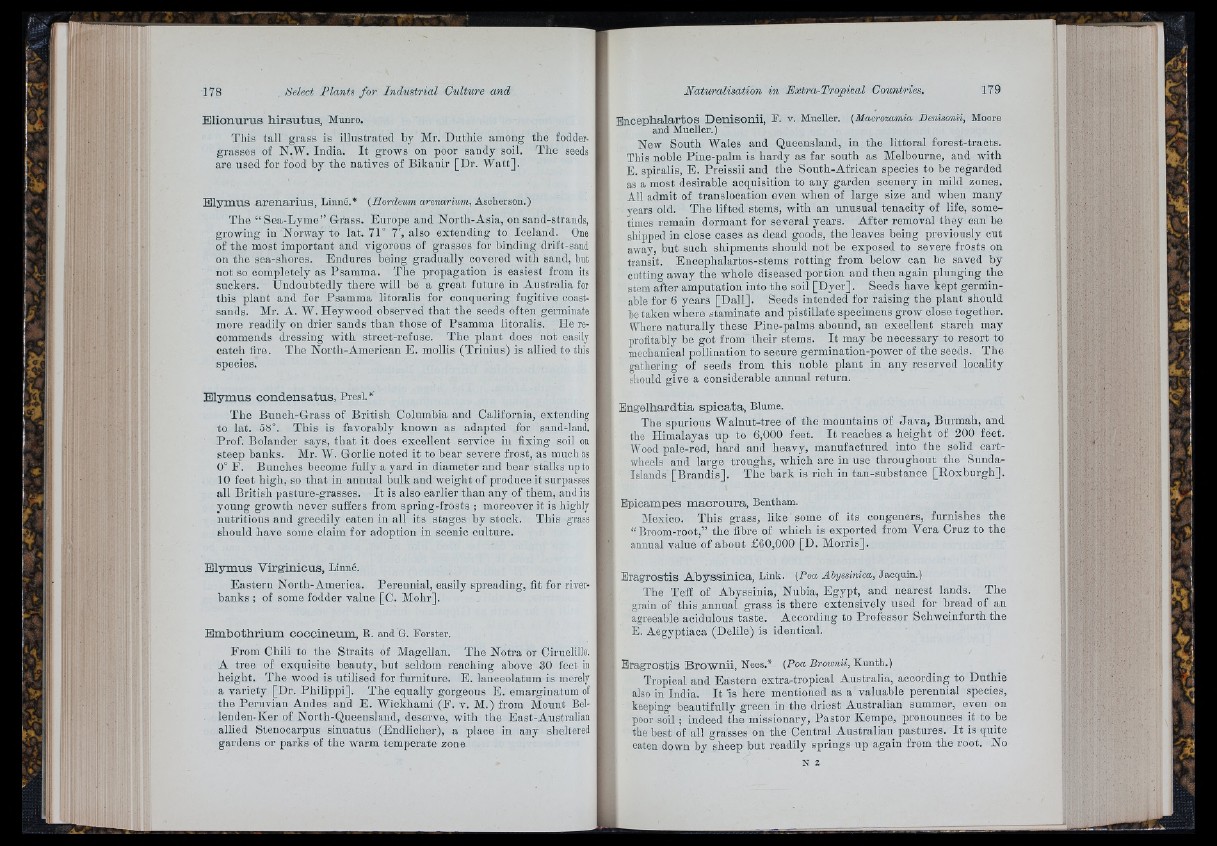
Y;
1fr.
i • .
■
E lio n u ru s h ir s u tu s , Munro.
Tills tall grass is illustratecl by Mr. Dutliie among the fodder-
grasses of N.W. India. I t grows on poor sandy soil. The seeds
are used for food by the natives of Bikauir [Dr. Watt].
E lym u s a r e n a r iu s , Linné.* {Hordeum arenarium, Ascherson.)
The “ Sea-Lyme” Grass. Europe and North-Asia, on sand-strands,
growing in Norway to lat. 71° 7', also extending to Iceland. One
of the most important and vigorous of grasses for binding drift-sand
on the sea-shores. Endures being gradually covered with sand, but
not so completely as Psamma. The propagation is easiest from its
suckers. Undoubtedly there will be a great future in Australia for
this plant and for Psamma litoralis for conquering fugitive coast-
sands. Mr. A. W. Heywood observed th a t the seeds often germinate
more readily on drier sands than those of Psamma litoralis. He recommends
dressing with street-refuse. The plant does not easily
catch fire. The North-American E. mollis (Trinins) is allied to this
species.
E lym u s c o n d e n s a tu s , Presl.*
The Bnnch-Grass of British Columbia and California, extending
to lat. 58°. This is favorably known as adapted for sand-land.
Prof. Bolander says, th a t it does excellent service iu fixing soil on
steep banks. Mr. W. Gorlie noted it to bear severe frost, as much as
0° F . Bunches become fully a yard in diameter and bear stalks up to
10 feet higli, so th a t in annual bulk and weight of produce it surpasses
all British pasture-grasses. I t is also earlier tban any of them, and its
young growth never suffers from spring-frosts ; moreover it is highly
nutritious and greedily eaten in all its stages by stock. This grass
should have some claim for adoption in scenic culture.
E lym u s V irg in ic u s , Linné.
Eastern North-America. Perennial, easily spreading, fit for river-
banks ; of some fodder value [C. Mohr].
B m b o th r ium o o o ç in eum , R. and G. Forster.
From Chili to the Straits of Magellan. The Notra or Ciruelillo.
A tree of exquisite beauty, but seldom reaching above 30 feet in
height. The wood is utilised for furniture. E. lauceolatum is merely
a variety [Dr. Philippi]. The equally gorgeous E. emarginatum of
the Peruvian Andes and E. Wickhami (F. v. M.) from Mount Bel-
lenden-Ker of North-Queenslaud, deserve, with the East-Anstralian
allied Stenocarpus sinnatus (Endlicher), a place in any sheltered
gardens or parks of the warm temperate zone
E n c ep h a la rto s D en iso n ii, F. v. Mueller. (Macrozamia Moore
and Mueller.)
New South Wales and Queensland, in the littoral forest-tracts.
This noble Piue-palm is hardy as far south as Melbourne, and with
E. spiralis, E . Preissii and the South-African species to be regarded
as a most desirable acquisition to any garden scenery in mild zones.
All admit of translocation even wben of large size and when many
years old. The lifted stems, with an unusual tenacity of life, sometimes
remain dormant for several years. After removal they^ can be
shipped in close cases as dead goods, the leaves being previously cut
away, but such shipments should not be exposed to severe frosts on
transit. Encephalartos-stems rotting from below can be saved by
cutting away the whole diseased portion and then again plunging the
stem after amputation into the soil [Dyer], Seeds have kept germinable
for 6 years [Dali]. Seeds intended for raising the plant should
be taken wdiere staminate and pistillate specimens grow close together.
Where naturally these Pine-palms abound, an excellent starch may
profitably be got from their stems. I t may be necessary to resort to
mechanical pollination to secure germination-power of the seeds. The
gathering of seeds from this noble plant in any reserved locality
should give a considerable annual return.
Bn g e lh a rd tia s p ic a ta , Blume.
The spurious Walnut-tree of the mountains of Ja v a , Bnrmah, and
the Himalayas up to 6,000 feet. I t reaches a height of 200 feet.
Wood pale-red, hard and heavy, manufactured into the solid cartwheels
and large troughs, which are in use throughout the Sunda-
Islands [Brandis]. The bark is rich in tan-substanoe [Roxburgh].
Epioampes m a c ro u r a , Bentham.
Mexico. This grass, like some of its congeners, furnishes the
“ Broom-root,” the fibre of which is exported from Vera Cruz to the
annual value of about £60,000 [D. Morris].
Eragrostis A b y s s in ic a , Link. (Poa Ahyssinica, Jacquin.)
The Teff of Abyssinia, Nubia, Egypt, and nearest lands. The
grain of this annual grass is there extensively used for bread of an
agreeable acidulous taste. According to Professor Schweinfurth the
E. Aegyptiaca (Delile) is identical.
E ragrostis B row n ii, Nees.* (Poa Brownii, Kunth.)
Tropical and Eastern extra-tropical Australia, aecording to Duthie
also in India. I t 'is here mentioned as a valuable perennial species,
keeping beautifully green in the driest Australian summer, even on
poor soil ; indeed the missionary. Pastor Kempe, pronounces it to be
the best of all grasses on the Central Australian pastures. I t is quite
eaten down by sheep but readily springs up again from the root. No
N 2
■■ ■
hi'
Ii' v-V , i. i”.
f r l f r f y fri'. ^ '
iSfrV pfr
V ’•D-'l-"' I- • ii'iriifr. u,'
l u i .
: i f # l - i
iÌiLifri'-'i’.l
11^ ’